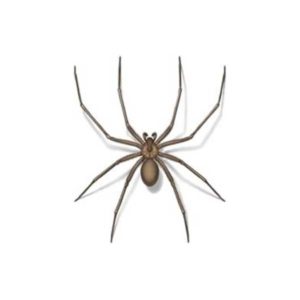The media hype surrounding the Brown Recluse Spider, along with the often mis-identification of spider bites has led to a large amount of unwarranted hysteria surrounding this particular spider. Here at Western Exterminator we often get asked questions regarding this infamous spider and how to identify it, and in particular how to tell it apart from its close relative, the Desert Brown Spider.
It is also notable that Brown Recluse Spiders are not nearly as prevalent in Southern Nevada, Las Vegas and Henderson as the Desert Brown Spider.
Identifying Characteristics of the Brown Recluse Spider
The Brown Recluse – Violin Marking
Many people misidentify the Brown Recluse Spider just based upon the Violin, often referred to as Fiddle markings on the spider’s body, technically referred to as a cephalothorax. The spiders legs, eyes, and mouth fangs are attached to the cephalothorax. The color of this Violin shape will be dark brown in color. Other identifying characterizes of the Brown Recluse Spider are listed below:
- Color of spider will be uniform, light tan to dark brown
- Long thin legs
- Oval abdomen, with no markings
- 3 sets of eyes
- Spiders abdomen will be uniform in color, with fine hairs
- The spiders legs are smooth, with no spines
- Spiders legs will be uniformly colored
- Spiders body will measure no more than 1/2 of an inch in length
- And, of course there will be a dark brown Violin shape on the spiders cephalothorax
Identifying Characteristics of the Desert Brown Spider

Closely related to the Brown Recluse Spider is the Desert Brown Spider, they’re from the same Genus: Loxosceles. Just like Brown Recluse Spiders, the Desert Brown Spider can (not always) have a Violin shaped marking on its cephalothorax, but often it is much lighter in color when compared to the dark brown markings on a Brown Recluse. As both are from the same family and genus of spiders, many of the characteristics are the same.
Desert Brown Spiders are typically yellowish-brown to tan in color, and measure the same size as a Brown Recluse at up to ½ an inch in length.
Bites from these spiders
Desert Brown Spiders are much more prevalent in the Las Vegas area, when compared to the Brown Recluse. In either event, both spiders are dangerous as their bites are necrotic. Bites from this family of spiders can cause severe tissue damage, which can result in a large open sore called a necrotic lesion.
Desert Brown Spider & Brown Recluse Extermination
The dangers associated with having these types of spiders in your home warrants asking for professional help for many home owners. Enlisting the help of a professional pest control company can help home owners identify areas of concern, and treatment options to keep these unwanted visitors out of your home.
